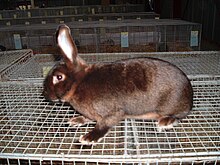Satin rabbit
The satin rabbits are a group of rabbit breeds that differ from the other breeds by their silky, shiny fur.
Special features of the satin rabbits
The silk-like shine of the hair comes about through a mutation of the genetic factor Sa (normal hair) to sa, which is recessive compared to normal hair, which causes a thinner silk-like structure of the hair. Similar to the Rex rabbits , this mutation was accompanied by a reduced vitality of the animals, which, however, has now been remedied by breeding measures. The fur hair of the Satin is approx. 3.5 cm long, the awns are fine and only protrude slightly above the hair. The under hair is very thin. The individual hair is covered by a thin, transparent layer of very fine, flaky or shingle-like surface membranes. Due to the special hair structure, the coat colors of the satin rabbit are particularly clearly visible, which in connection with the silk gloss determines the special character of this breed. The satin rabbits form the division of hair structure breeds in the division of the Central Association of German Racial Rabbit Breeders.
The following colors are recognized for the satin rabbits:
Satin-ivory
Plain white satin rabbits; the otherwise white skins appear ivory-colored due to the hair structure . Both albinotic animals with red eyes and leucistic hues (blue eyes) are permitted.
Satin black
Plain black animals in the style of Alaska .
Satin blue
Monochrome blue animals, the blue corresponds to that of the Blue Viennese , but appears much darker.
- the claws are dark horn-colored
- the eye color is prescribed as blue, but in most animals it tends to be brown and has to be bred out
- the entire coat color is blue, without any wild-color markings; the underside of the legs is lighter and goes into white - the under color should hardly stand out from the over color and be blue; however, it becomes lighter with every hair change and becomes white in older animals - this is not desirable and must also be improved
Satin Havana
Plain chocolate brown animals. This is the original color, as satin first appeared in America as a mutation in litters of Havana rabbits . (See breed history)
Satin-red
Solid red fur, the color corresponds to that of the Red New Zealanders and the Sachsengold .
Satin-Feh
Light blue fur with a light brown streak, corresponding to the color of the Marburg Feh .
Satin Californian
Ivory animals with red eyes and black muzzle, ears, legs and flowers. The drawing and how it came about corresponds to that of the Russian rabbits and Californians .
Satin rabbit colored The
color corresponds to that of the rabbit .
Satin Thuringian Satin
rabbit with the color of the Thuringian .
Satin chinchilla
Satin rabbit with the color of the chinchilla rabbit .
Satin Siamese
Color corresponds to the Siamese rabbit .
Satin Castor Satin
rabbit in the color of the Castor Rex .
Satin-Lux
color corresponds to the Lux rabbit .
History of the satin rabbits
Satin rabbits first appeared in litters of Havana rabbits at Walter Huey in the US state of Indiana in 1930 . As with the emergence of other races, such a mutation seems to have taken place earlier. So is the occasionally be crossed in the Havana rabbit rabbit rabbit reported that 1918/1919 a so-called Satinetten impact would have occurred with a silky luster of the 'skins, but at that time not led to breeding. The Dutch breeder JH Eck van der Sluys is said to have had great success with deep red, silky, shiny rabbits. It is unclear whether it was the same mutation as in the satin rabbits. Huey systematically further developed the satin rabbits he had encountered, selecting in particular for vitality, since the first satin rabbits, similar to the Rex rabbits , suffered from reduced resistance. In addition to the original Havana-colored satin rabbits, other colors have already emerged. In 1936 a special club for satin rabbits was founded in the USA, and satin rabbits were exhibited for the first time in 1938. In addition to Walter Huey, John Fehr and JT Price made particular contributions to the development of the breed. In 1946 the American Satin Rabbit Breeders Association was founded. The satin rabbits were first imported to Europe in 1947 to Great Britain , where the breed quickly became widespread. The satin rabbit was imported to Germany in 1970 by Müller, Hameln . Further imports from the USA followed , and the breed was recognized in the 1970s.
Similar races
The satin factor can also be transferred to Rex and Angora rabbits . These combinations are not recognized in Germany, but exist in Great Britain and the USA .
literature
- W. Schlohlaut: The big book of the rabbit. 2nd Edition. DLG-Verlag, Frankfurt 1998, ISBN 3-7690-0554-6 .
- JC Sandford: The domestic rabbit. 5th edition. Blackwell Science, Oxford 1996, ISBN 0-632-03894-2 .
- U. Reber: Satin stories - 75 years of development - 35 years of breeding in Germany. In: The small animal breeder - rabbit. 2/2006, p. 4/6. ISSN 1613-6357


